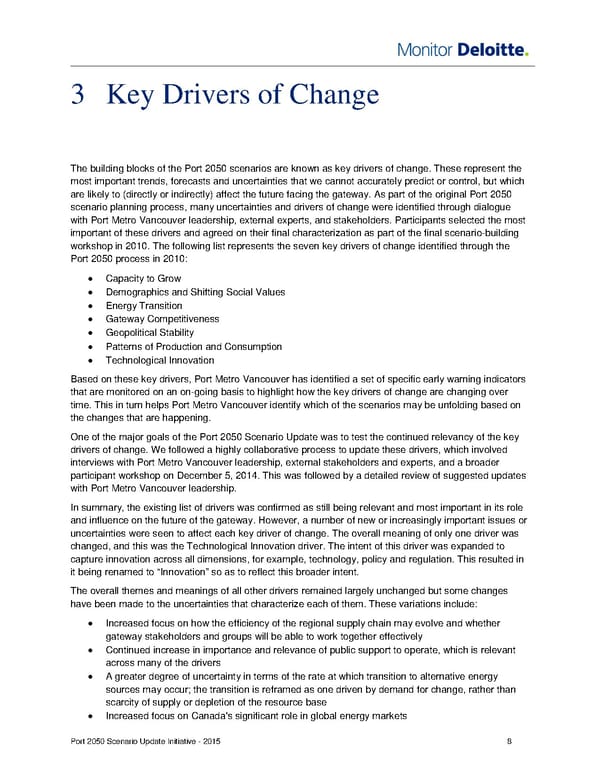3 Key Drivers of Change The building blocks of the Port 2050 scenarios are known as key drivers of change. These represent the most important trends, forecasts and uncertainties that we cannot accurately predict or control, but which are likely to (directly or indirectly) affect the future facing the gateway. As part of the original Port 2050 scenario planning process, many uncertainties and drivers of change were identified through dialogue with Port Metro Vancouver leadership, external experts, and stakeholders. Participants selected the most important of these drivers and agreed on their final characterization as part of the final scenario-building workshop in 2010. The following list represents the seven key drivers of change identified through the Port 2050 process in 2010: • Capacity to Grow • Demographics and Shifting Social Values • Energy Transition • Gateway Competitiveness • Geopolitical Stability • Patterns of Production and Consumption • Technological Innovation Based on these key drivers, Port Metro Vancouver has identified a set of specific early warning indicators that are monitored on an on-going basis to highlight how the key drivers of change are changing over time. This in turn helps Port Metro Vancouver identify which of the scenarios may be unfolding based on the changes that are happening. One of the major goals of the Port 2050 Scenario Update was to test the continued relevancy of the key drivers of change. We followed a highly collaborative process to update these drivers, which involved interviews with Port Metro Vancouver leadership, external stakeholders and experts, and a broader participant workshop on December 5, 2014. This was followed by a detailed review of suggested updates with Port Metro Vancouver leadership. In summary, the existing list of drivers was confirmed as still being relevant and most important in its role and influence on the future of the gateway. However, a number of new or increasingly important issues or uncertainties were seen to affect each key driver of change. The overall meaning of only one driver was changed, and this was the Technological Innovation driver. The intent of this driver was expanded to capture innovation across all dimensions, for example, technology, policy and regulation. This resulted in it being renamed to “Innovation” so as to reflect this broader intent. The overall themes and meanings of all other drivers remained largely unchanged but some changes have been made to the uncertainties that characterize each of them. These variations include: • Increased focus on how the efficiency of the regional supply chain may evolve and whether gateway stakeholders and groups will be able to work together effectively • Continued increase in importance and relevance of public support to operate, which is relevant across many of the drivers • A greater degree of uncertainty in terms of the rate at which transition to alternative energy sources may occur; the transition is reframed as one driven by demand for change, rather than scarcity of supply or depletion of the resource base • Increased focus on Canada's significant role in global energy markets Port 2050 Scenario Update Initiative - 2015 8
 Monitor Deloitte - Final Report Page 9 Page 11
Monitor Deloitte - Final Report Page 9 Page 11